CRM in Practice 2021/2022: User Satisfaction, Benefits & Perspectives
“How satisfied are CRM users with their CRM solutions?” This exciting question is posed by the “CRM in Practice 2021/2022: User Satisfaction, Benefits & Perspectives” study by Trovarit AG.
Especially due to the recent events of the COVID-19 pandemic, a “new normal” has emerged in a short time for the requirements of any CRM system.
Will CRM meet these new application challenges in practice from the user’s point of view? What are the most important features of a CRM for users at the moment? What trends do respondents currently see? This and more is shown in this article.
The highlights of the article at a glance:
- Basically user satisfaction
- Flexible software at an advantage
- Documentation and training are decisive for success
- Attention stumbling block: Software integration
- CRM trends from the user’s point of view
Excursus: Who are the participants and which systems were considered?
The study is based on a data collection that was carried out between mid-April and early July 2021.
The data was collected online by the market research company techconsult in Kassel, a subsidiary of the Heise Group. A total of 544 questionnaires were evaluated.
At the same time, Trovarit AG also carried out an online survey in which an identical questionnaire was used. The study was directly supported by some system providers. This survey resulted in 104 usable questionnaires.
With a share of about 44%, the surveyed participants represent the perspective of the operational area (marketing, sales, service …). IT/EDP are represented with 19%. The area of Finance/Controlling is represented with 9% and the management comes to 8%.
With regard to their user role, the surveyed participants are responsible for IT operations with a share of about 22%. Approximately 32% belong to “intensive users” and about 24% to “information users”. The last relevant group of participants with about 17% are the CRM administrators.
Only about a quarter of CRM installations are very up-to-date with a release change of less than one year. In more than 20% of the installations examined, however, the release status is already four or more years old.
A total of 139 different CRM systems were evaluated. However, a stable statement on user satisfaction is only possible for 8 systems. These are CURSOR CRM, ASSIST-Pro, CAS genesisWorld, cobra CRM, SAP CRM, MS Dynamics CRM, Salesforce and Oracle.
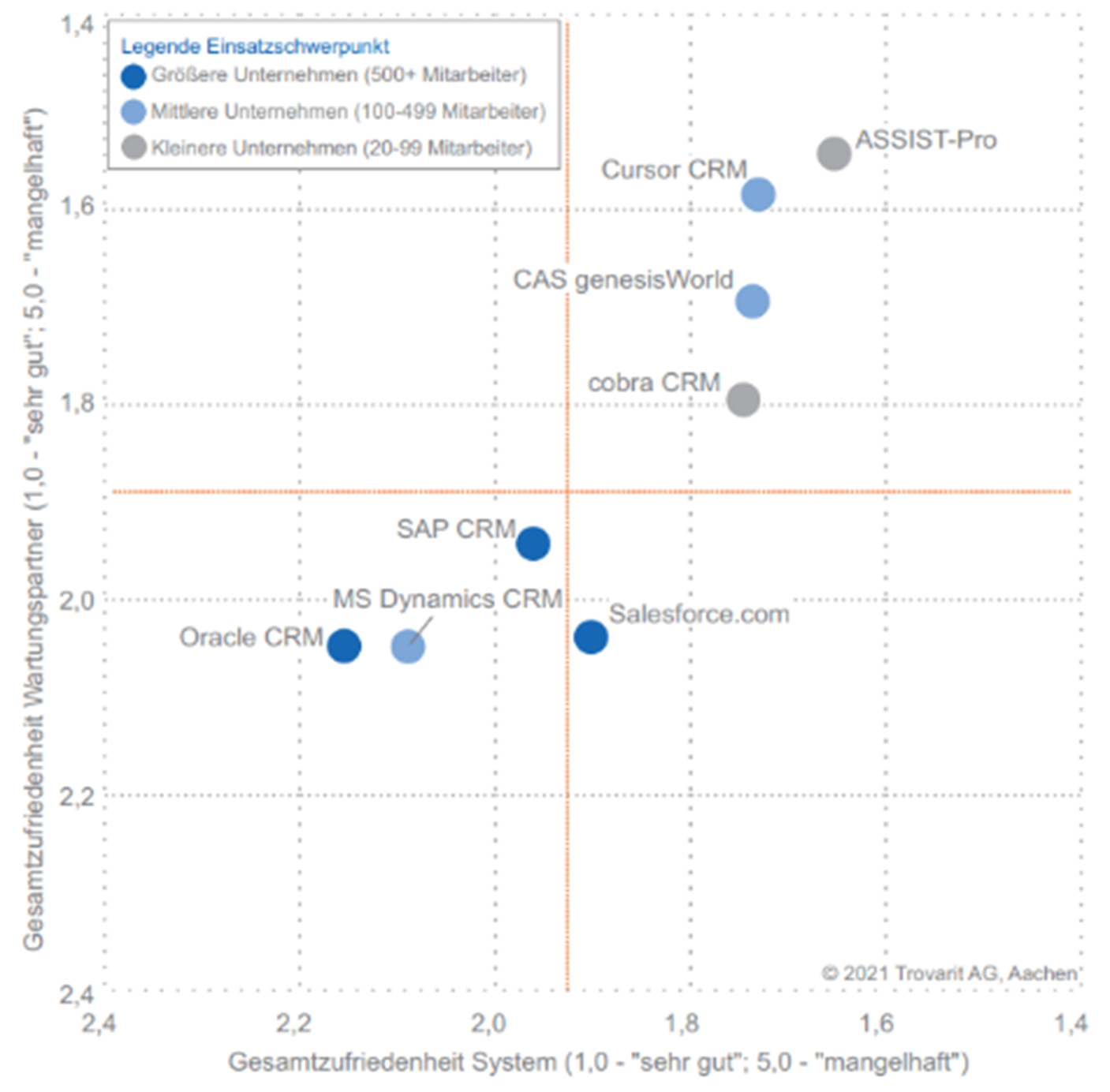
Basically: Good satisfaction among users of the evaluated CRM systems
The CRM market can be quite satisfied with the overall score: The systems receive a 2 plus (1.9) from their users. CRM in practice therefore has a good status and is accepted by the users.
Even if the criterion “satisfaction” is a subjective quantity, the results are still meaningful due to the number of participants. This definitely reflects the positive perception in the market.
This high level of satisfaction with CRM in practice is not self-evident. According to another study, software users (66% of 500 inside sales respondents) prefer to clean their bathroom instead of working with their CRM (we reported). 😉
CRM in practice: The most important points for dissatisfaction
Based on the results, a number of important aspects emerge. Particular attention must be paid to these in the context of software selection, software introduction and during the operation of a CRM solution. This is the only way to counteract dissatisfaction in the long term.
These are mainly:
- System-related aspects (adaptability/flexibility, documentation/manual, mobile applicability and forms as well as data evaluations)
- Support (advice on the use of the solution and training & information offer)
- Classic project parameters (target achievement and documentation of system adaptations)
Software must be flexible
From our point of view, it is no surprise that the system-related aspects perform the worst among all the satisfaction characteristics queried, because these usually describe the adaptability of a system. This is usually cost-intensive and therefore often the first victim of cost-cutting measures.
In practice, CRM is particularly flawed in the adaptability/flexibility of the systems and their mobile use. Both obviously do not meet the expectations of the users and are reflected in our practical experience. Especially in order to save costs during the introduction, (cost-intensive) programming effort is often dispensed with in practice, which allows flexibility. There is often the assumption that the standard of a software is sufficient for one’s own processes.
A countermeasure of CRM in practice is the introduction of more and more no-code and low-code functionalities. A trend that we are also observing. This gives users the opportunity to create flexibility and adaptability for themselves.
But beware: One problem should not be ignored: All these functions can only bring success to a user who has motivation and know-how to deal with the given functions.
Documentation and training remain important in CRM in practice
As in the previous studies, the topic of “documentation” – and thus also the training for CRM in practice – once again provides cause for criticism. At this point, several developments come together:
1.) The solutions become more comprehensive and their operation more demanding.
2.) At the same time, the innovation frequency and scope of the solutions are increasing.
3.) Training and information needs of end users increase due to 1.) and 2.) clear.
Especially the target group-oriented, up-to-date documentation requires a lot of effort and costs. From our experience in CRM in practice, there is often a lack of suitable training concepts, but also a willingness to invest in this area.
In practice, this problem is exacerbated even more by the scope of many different software modules and the urge for customer-specific individualization of all these functions. At this point, in our experience, it often becomes clear that “less is more”. This means that not all processes have to be mapped in the CRM right from the start. More important is the correct integration of the selected processes with the associated functions. “Half-measures” as a solution must be avoided. The range of functions must not be compromised just to have a function in the system. A function that is not fully mapped leads to more frustration than benefit.
What strengthens CRM satisfaction in practice?
Looking at the drivers of dissatisfaction in CRM systems is one thing, the other is that we must never lose sight of the other side.
So what creates a high degree of satisfaction among users when working with CRM in practice?
3 reasons contribute significantly to satisfaction when considering the Trovarit study:
Low complexity
Leaner implementations based on functionally or industry-specific clearly focused CRM solutions have less complexity, so that introduction and administration as well as updating are less time-consuming and the operation requires less explanation. This is exactly the mirror image of the previously described problem that the software is becoming more and more extensive – a user must not be overwhelmed with functions.
Close customer relationship
The establishment and maintenance of (personal) relationships with customers and their individual support by the manufacturer or its implementation partners is decisive for customer satisfaction. An example highlighted by Trovarit is CAS Software AG with genesisWorld, which itself or supported by its implementation partners maintains a very intensive and personal relationship with its customers, which is reflected, among other things, in the overall satisfaction with the system.
Current technology/release statuses
If installations are technologically up-to-date (release) state-of-the-art, then they usually have better surface ergonomics or user guidance as well as better adaptability. So: The user interface, without too many functions, can decide. This again shows the desire for low complexity.
Stumbling block: Software implementation for CRM in practice
According to the underlying study, the duration of implementations (from purchase decision to go live) is between 3 and 9 months for 67% of CRM implementations. From our practical point of view, this value occurs in the rarest of cases.
Because: The duration of the implementation can be significantly longer even for smaller companies and much faster for medium-sized and larger companies, due to increased complexity and the higher degree of integration.
In addition, the risks often cited in connection with the implementation problems, such as lack of project resources, errors in project planning or problems with data migration, can have a significant, difficult to assess influence on the final implementation time. Data migration in particular is a problem that cannot be ignored for many companies, especially when it comes to cleaning up existing data.
Processes are important
It should also be noted that CRM projects are not pure IT projects. They have both procedural and strategic implications. Processes that have to be mapped with crm must fit in with it and it must not be shied away from the question of how CRM can change a process in practice.
Management control is important
The same applies to the strategic management of a company, which can change as a result of CRM. Through a CRM, a new control of the tasks is often possible. However, this can only be lived if the innovations are exemplified and demanded by the management in the company.
The 5 most common problems of software introduction in CRM in practice
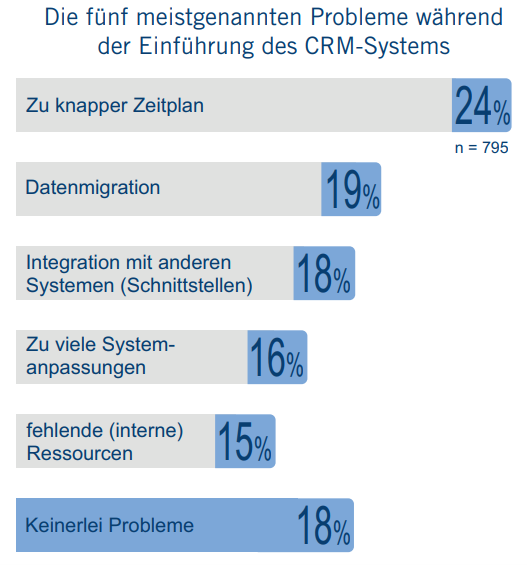
The most important topics about software implementation and the biggest dangers with this can be found in our main article on CRM software introduction.
Trends for CRM in practice
The topics are data and information security, which are very or fairly relevant for 71% of the participants. In addition, there are legal requirements & compliance guidelines (61%), improved usability and software ergonomics (approx. 56%), which results from the desire for lower complexity.
Trend: Data security
The importance of “data security” can be derived from the role of CRM software for all customer-specific processes in the company. CRM manages the most important master and transaction data and is responsible for the entire life cycle of the customers. Against the background of increasing (cross-divisional) networking and mobility of CRM use, the requirements for data protection mechanisms are also increasing significantly in the context of CRM systems.
Trend: Compliance
The high priority of the topic “Legal Requirements & Compliance” is certainly due to the EU General Data Protection Regulation (GDPR), which has been in force since 2016, which poses challenges for companies in the legally compliant handling of personal data, especially in marketing and sales.
Trend: Usability
The great importance of “usability/software ergonomics” reflects the desire of companies that the interfaces and processes are simply designed. A user should like to work with the system and with little training effort (intuitively). Especially at the beginning of CRM software use, an intuitive user interface is essential for the user experience and acceptance of the system.
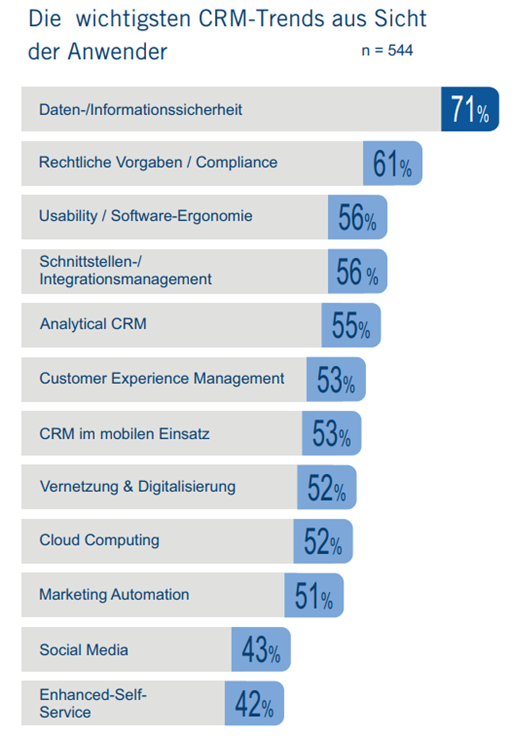







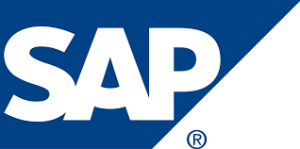
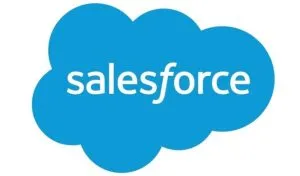

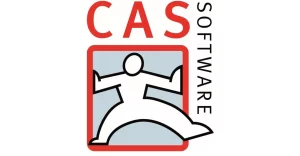 CAS Software AG ist Marktführer für Kundenbeziehungsmanagement (CRM) im deutschen Mittelstand. Ob Marketing, Vertrieb oder Service – Anwender profitieren von effizienten Prozessen auf einer einheitlichen Datenbasis.
CAS Software AG ist Marktführer für Kundenbeziehungsmanagement (CRM) im deutschen Mittelstand. Ob Marketing, Vertrieb oder Service – Anwender profitieren von effizienten Prozessen auf einer einheitlichen Datenbasis.





